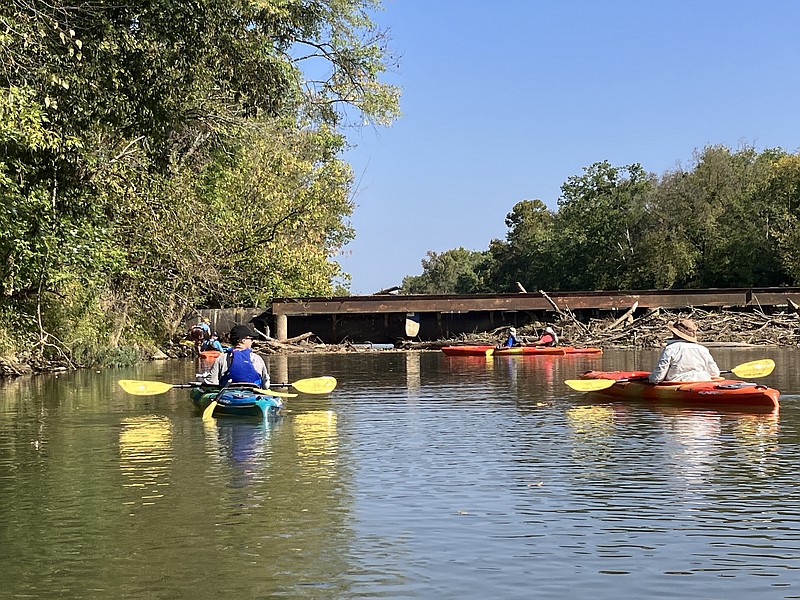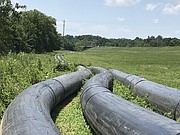A monstrous, decades-old sewer pipe crossing South Chickamauga Creek just downstream from Brainerd Road in Chattanooga forms a blockade against paddlers, forcing people in canoes and kayaks to turn around or commit to a sketchy portage to get past the 5-foot-high structure.
Erosion from flooding is making it worse, too, according to Jim Ledbetter, an avid paddler at war with logjams and paddling obstacles around the region. Ledbetter is working to team with like-minded paddlers and city officials and a local philanthropic foundation to find a workable solution for the creek's waterborne users to get around the sewer line. The city's new Parks and Outdoor Plan could provide a pathway to a solution.
South Chickamauga Creek flows north between the Chattanooga Airport and Brainerd High School, where the sewer line, at least 180 feet long, crosses the portion of the creek created when a flood control levy was constructed after the St. Patrick's Day flood of 1973.
"It's dangerous and awkward, and it blocks off one of the best paddling creeks around Chattanooga," Ledbetter said of the problem pipe in a phone interview. "Everything else you pass under quite easily. There are a few railroad trestles over the creek that will catch logs sometimes, but they're usually fairly easy to get around."
For paddlers, South and West Chickamauga creeks offer more than 50 miles of almost uninterrupted paddling with no competing motorized boat traffic, according to Ledbetter. Both creeks have several launches for kayaks and canoes as far south as Ringgold — the headwaters of both creeks are in Georgia — continuing downstream to the confluence with the Tennessee River near Chattanooga State Community College on Amnicola Highway.
(READ MORE: Chattanooga plans to add hundreds of acres of new park space in coming decades)
It's mostly smooth sailing until paddlers meet up with the sewer pipe and have to carry their craft around it.
"It could be the most popular section, but paddlers don't like to have to portage around the sewer pipe," Ledbetter said.
Not far downstream from the pipe, a piece of South Chickamauga Creek's original stream bed was left behind after the 1970s-era Tennessee Valley Authority's $15 million South Chickamauga Creek flood control project to build the levy by the end of the 1970s with several sections of the original creek straightened into a new artificial channel, according to Chattanooga Times Free Press archives.
The project was launched after 7.5 inches of rain fell in Chattanooga between March 15 and March 17, 1973.
Chattanooga was among the larger cities hardest hit by the St. Patrick's Day flood in 1973, particularly the Brainerd area, where massive flooding occurred along South Chickamauga Creek and at the city's airport, according to National Weather Service records. The Tennessee River crested at 10 feet above flood stage in the city, and damage topped $35 million, with hundreds of homes and businesses flooded. More than 300 families from the city were evacuated from their homes.
The original stream bed that winds away from the artificially straightened creek channel features some of the best scenery along the Brainerd stretch of the creek, Ledbetter said.
"When I paddle the creek, I always take the old stream; it's much more interesting," he said. "It's wooded on both sides, there's lots of heron and deer and coyote and all sorts of wildlife in that meandering, old stream bed."
Conversations were had several years ago about a solution for the paddling blockade, and the nonprofit Lyndhurst Foundation expressed interest in helping out.
"In April 2016, the South Chickamauga Creek Greenway Alliance invited interested parties to visit the site of this crossing," Ledbetter said in a written description of the proposed fix that would add stability to the line. "The purpose was to view and discuss the condition of the eroding left bank and how the exposed, unsupported section of pipe was becoming more and more endangered. In addition, we wished to voice the desire of the paddling community to incorporate an acceptable portage design into the eventual stabilization which would someday need to be installed."
The idea to remove the blockage is still supported, according to the foundation's president.
"It has been over five years since Lyndhurst attended a meeting with representatives from the city of Chattanooga and the paddling community to pursue an opportunity for providing structural improvements to the large sewer pipe that crosses South Chickamauga Creek while simultaneously constructing a compatible landing that affords canoeists, kayakers and paddleboarders with a safe and convenient portage around this obstruction," foundation President Benic M. "Bruz" Clark said via email. "Outdoor recreation continues to be a programmatic funding priority for Lyndhurst, and the city of Chattanooga has indicated that the expansion of our local and regional blueway amenities is a priority under its recently released Parks and Outdoors Plan."
If interested parties unify on the idea, the foundation is ready to help.
"The foundation would be willing to entertain a proposal for constructing a portage in partnership with the city and the paddling community should a plan be devised that satisfies whatever engineering and permitting requirements are necessary and is affordable," Clark said.
South Chickamauga Creek is already part of the city's Parks and Outdoors Plan as a top priority blueway, according to Chattanooga Parks and Outdoors spokesperson Brian Smith.
"The South Chickamauga Creek Blueway is in the Parks and Outdoors Plan as a first move to expand paddling access into the core of our city," Smith said in a phone message. "To activate this regional resource fully for public use and enjoyment, we will add paddling access sites, add signage on the creek to aid orientation for paddlers."
The plan, released by the city in June, is an effort to make it easier for residents in all areas of the city to get to parks by increasing the land available for recreation. The plan builds on a century-old idea to create a "city in a park" introduced by Chattanooga's first park planner, landscape architect John Nolen. The city's plan builds on many elements of Nolen's 1911 plan, with modern challenges identified and a 21st century take on residents' outdoor needs. Nolen's work in Madison, Wisconsin, is still recognized today for its design.
The sewer pipe will be part of plans for the creek, Smith said.
"We are working with partners to create a safer paddling experience by working collaboratively on future projects like portages around the areas that might be obstructed," he said. "These projects and plans are in discussion phases now."
As the blueway is examined, Smith said a thorough assessment would be done.
"We're going to look at all obstructions to make sure it's safe at different water levels," Smith said.
Ledbetter was heartened to know the project could resume in the future, he said by phone Friday.
Contact Ben Benton at bbenton@timesfreepress.com or 423-757-6569.

